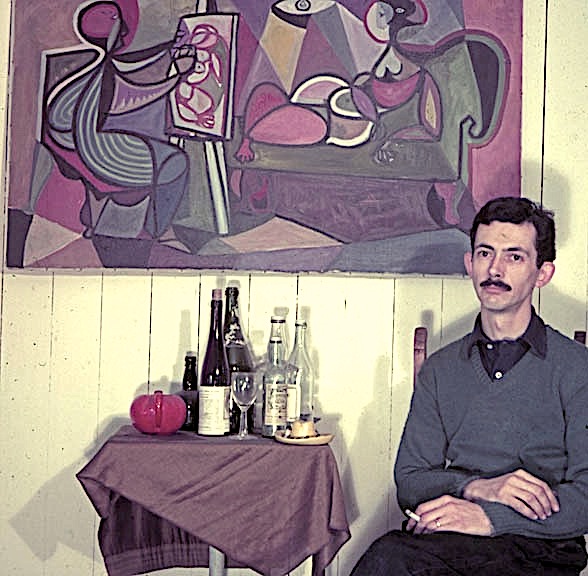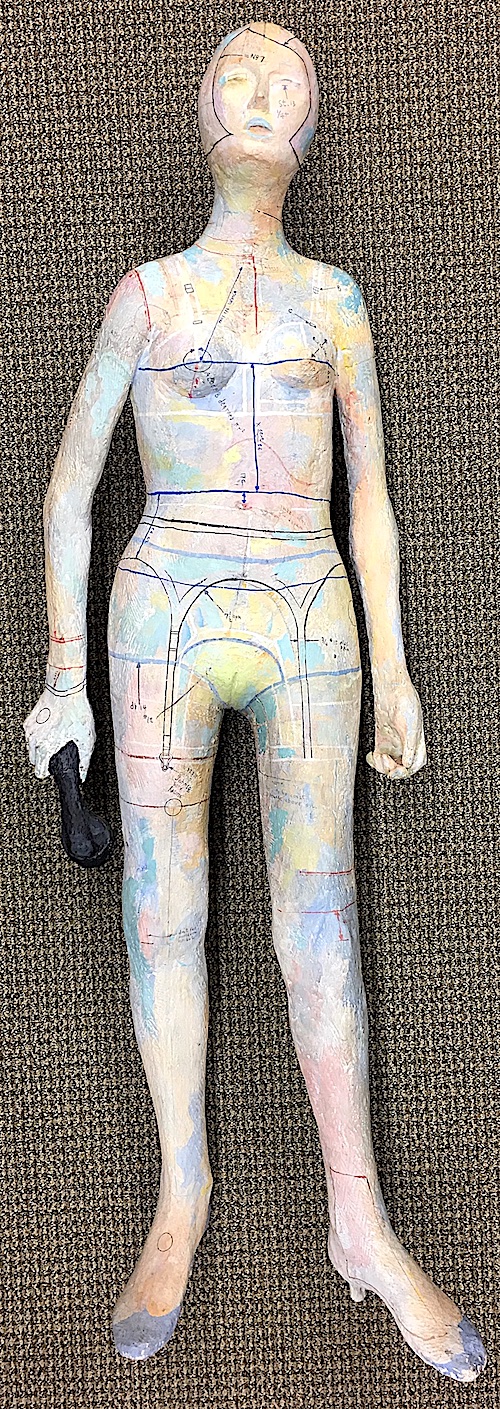“One small grain of sand, unstained”


In 1937 Ashlock entered the freshman class at the University of Washington in Seattle with every good intention of following a traditional education. But after his sophomore year he quit, compelled to pursue his passion for painting. His mother was supportive, but his father’s hostility to what he perceived as an insecure and unmanly calling never diminished. Ashlock moved to San Francisco and spent two years at the California School of Fine Arts. Walking long distances to find his sites, and carrying his paints and brushes around in a shoebox — he would battle financial stringencies all his life. Ashlock’s earliest works are largely of scenes around the Bay Area, painted in watercolor en plein air in the style of the Regionalists. He often spent early mornings at the racetrack, drawing the horses as they exercised, but the trainers, afraid of flapping papers, demanded he maintain a buddha-like composure as he drew, which perhaps contributed to the apparent simplicity in his lifelong working-habits.

Though Ashlock exhibited his works from time to time, he did so more out of what he perceived to be a social obligation — as a faculty member — and never actively promoted his work. He never hustled the galleries and museums but remained a classic example of the independent artist, quite wishing someone would notice but never exerting himself to bring that notice about. And perhaps because of that absence of professional fulfillment, and the unhappiness of a personal relationship in which he and his wife shared such different goals, Ashlock began to feel trapped, tormented, and prone to fits of anger. He was nearly forty, but a mature, consistent style of painting had not yet emerged. He described himself as an irascible character, at odds with the world. In 1957 he took advantage of an offer to ride East, packed his paintings onto the car-rack, and left his wife and two children to move to New York City.
His first years in Manhattan found Ashlock settled into tiny apartments, first in Chelsea, later in Greenwich Village. He complained about the lack of space. “Kline was painting his big black-and-whites, but it wasn’t easy for me to paint [large] . . . there was furniture, paint pots on the floor, no space, and no sense of comfort or convenience.” Nor, despite his dreams, did his personal relationships ever finally provide sustained emotional support. He could paint women; the female form was an endless source of inspiration for him, but as for living with the flesh-and-blood creature herself . . . gradually, he began to derive his comfort from whisky, cigarettes, cats, and the New York Times. As he settled into drinking at the Cedar Tavern, Ashlock soon became friendly with many of the abstract artists of the first generation of the New York School, including Franz Kline and Willem de Kooning. They were all still mourning the death of Cedar Tavern regular, Jackson Pollock. Ashlock recalled the summer of 1956 when, the day he arrived on his first exploratory visit to New York, the newspaper headline of Pollock’s death leapt out at him on the day he arrived.
Although Ashlock soon came to know many artists in New York (like “Kostas the Greek,” who had a photographic memory of where “every painting was to be found in every European museum”) it appears he had few lasting friends. Increasingly, he began to derive his comfort from whisky, cigarettes, cats, and the New York Times. And while his Ab-Ex friends were all painting large, Ashlock was restricted by his small apartments, leaving him impatient and frustrated. “Kline was painting his big black-and-whites, but it wasn’t easy for me to paint large… there was furniture, paint pots on the floor, no space, and no sense of comfort or convenience.” Nor, despite his dreams, did personal relationships ever provide sustained emotional support. The female form was an endless source of inspiration for him, but as for living with the flesh-and-blood creature herself… Nevertheless, he survived on an erratic income by securing illustration jobs at the New York Times, The New Yorker, and other magazines. From 1963 to 1970 he also taught a painting class at the Museum of Modern Art. Later, he taught at The Artists’ Workshop in New York and at the Princeton Art Association. In between he collected unemployment insurance.


In sculpture it was not surprising that Ashlock focused on the female form. Inspired by some of the polychrome wood-sculptures of Elie Nadelman [1885-1946], he began a series of female nudes in painted plaster. Years later, one of Ashlock’s students, Nathan Oliveira — who also became a colleague and fellow teacher — began a similar series of painted nudes for which he is now well-known.
It is these mature works, rooted in figurative expressionism, which bear his unique stamp. Like Cedar-tavern acquaintance, Willem de Kooning, Ashlock was fascinated by the female figure and never abandoned it as his primary source of inspiration. “I was influenced by de Kooning and Oskar Kokoschka and German Expressionism, but I didn’t want to go abstract. I wanted to represent something.” Ashlock pointed to Mondrian as one who was more interested in spiritualism than appearance, so that his paintings conveyed an underlying force. “Mondrian may not be so concerned with the look of things as with spatial relationships, patterns, and relations between lines and color. I find it hard to be totally non-representational. The look of things is important to me.” He was also impressed by the leading English figurative painters, Francis Bacon [1909-1992] and Lucian Freud [b.1922]. He lamented, “We haven’t produced anyone here in this country like Freud or Bacon.”

In Ashlock’s large seascapes of this same period one also feels a powerful sense of the dramatic. At first glance the viewer is faced with what appears to be a minimalist seascape of vast ocean and high horizon line. However, the eye naturally following the water suddenly plunges off the edge of the earth. We are alarmed to discover that the earth is flat! We are thrust back to the 12th century. Here is a time warp. The nexus of two worlds and two horizons are fighting for supremacy while twisting both perspective and spatial depth. This is an extraordinary series that finally reconciles pure abstraction, color field painting, calligraphic brush strokes of heavy impasto, and a recognizable subject — all into one picture plane. In fact, this series puts painting on its ear. Ashlock commented wryly that it was a matter of assuming “the perspective of several seagulls.”
For Ashlock, painting was above all about process: a process in which emotional, intellectual and physical depth was at play. In the two series discussed above, the nudes and the seascapes, it is clearly Ashlock’s desire to create the sense of motion, reinforced by color, that connects the two subjects. “At what point do you see the connections? . . . the image you want? The temptation is to continue the process, continue playing. The sense, however, is that it is important to keep putting on paint, that with the accretion of layers there is physically and emotionally greater depth.”
Ashlock remained invisible during his nearly twenty-five years in New York, living what he called “a lifestyle of extreme independence to” its fullest. Then, in 1980, he returned to the West Coast. He spent a few years in Spokane, Washington, where he continued the occasional portraits he had worked on over the years. Previously, he had painted from magazine photos – T.S. Eliot, Virginia Woolf, P.G. Wodehouse, W.H. Auden, who also lived on St. Mark’s Place, and whose lined face would sometimes appear in the Second Avenue tobacco shop they both frequented. He also painted Beckett, whose integrity he deeply respected. “I admired him the most,” Ashlock said, “because he turned down the Nobel Prize and then gave a speech to the press about how he felt that it was inappropriate to give prizes to works of art.” In Spokane, however, the portraits turned into a series of “imaginary friends.” Interestingly, some of the faces had more than a hint of self-portrait about them, as if he was beginning to think of himself more benignly.

After Spokane, Ashlock re-established himself in San Francisco, where he studied Chinese for several years, finally pursuing more fully his lifelong interest in the ‘visual word’. By this time, however, his former abuse of alcohol and cigarettes had begun to take its toll. His health deteriorated. Gradually, the artist found himself dependent upon others for his survival. During the 1990’s he was hospitalized for a variety of problems, ranging from heart ailments to an aneurysm. Eventually, he became bound to a wheelchair, exhausted by a kidney dialysis procedure that was required three times a week. Finally, in 1999, Rex Ashlock’s body gave in to its on-going struggle.
This is the story of a love affair with art. From his earliest years, fascinated by the tiny black-and-white reproduction of Rosa Bonheur’s “The Horse Traders,” which he found in a school-book — “I looked at it and looked at it . . . I just loved it,” Ashlock believed that the image was a gateway. What was he really seeing? And how, in all the folds of imagination, could he make perception visible? That quest — not the failed relationships; not the pain — was what was interesting. Painting the layers. Achieving cohesion. And without doubt, Ashlock’s capacity to realize his vision matured over the years in New York. He left us a series of powerful paintings, showing that whatever the personal toll, he never lost the excitement of the pursuit — these paintings tug at our senses for what “honest” paintings should be. Paintings that reveal an artist who never lost the excitement of the pursuit even though he never cared to promote his accomplishments.


In the process of rediscovering Ashlock’s painting and sculpture, we can draw a better understanding — and a fresh perspective — of the art and culture of the last half of the twentieth century. Here is art as honest as it gets. One small grain of sand, unstained.
— Peter Hastings Falk
